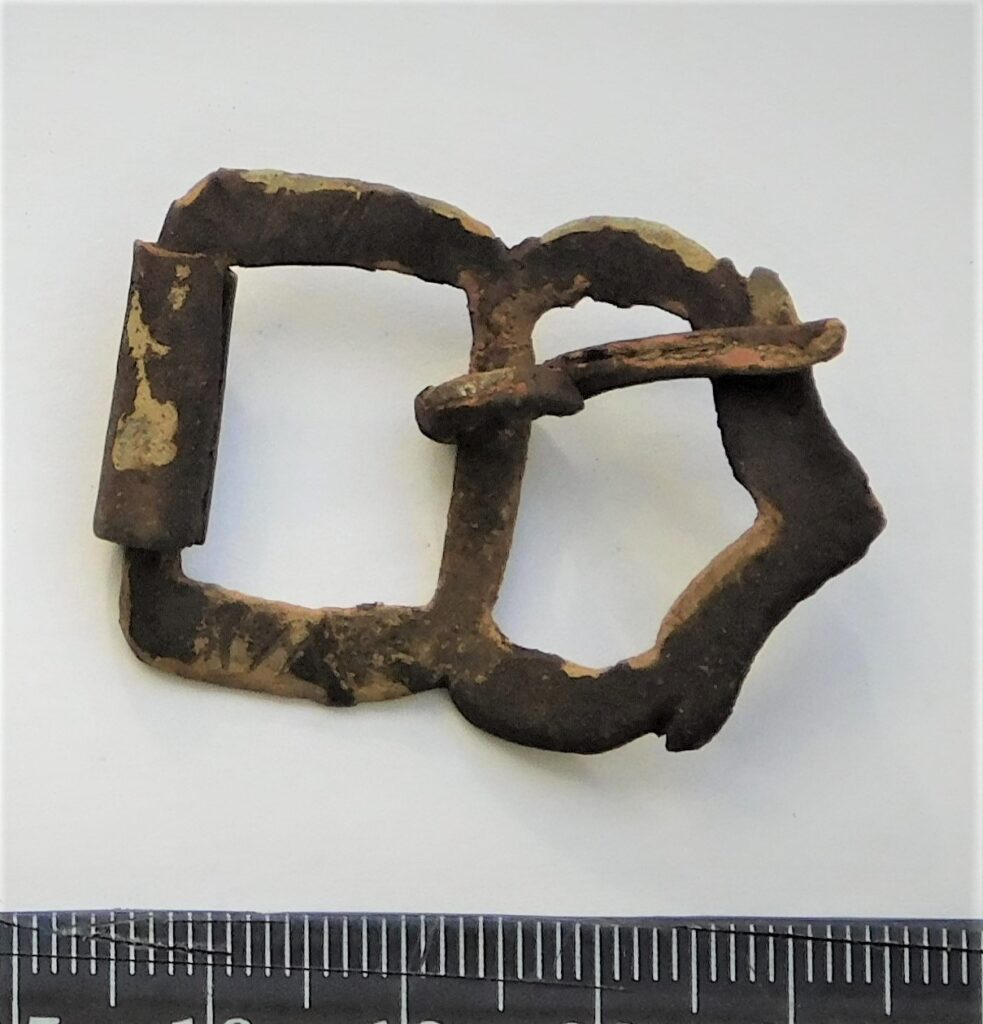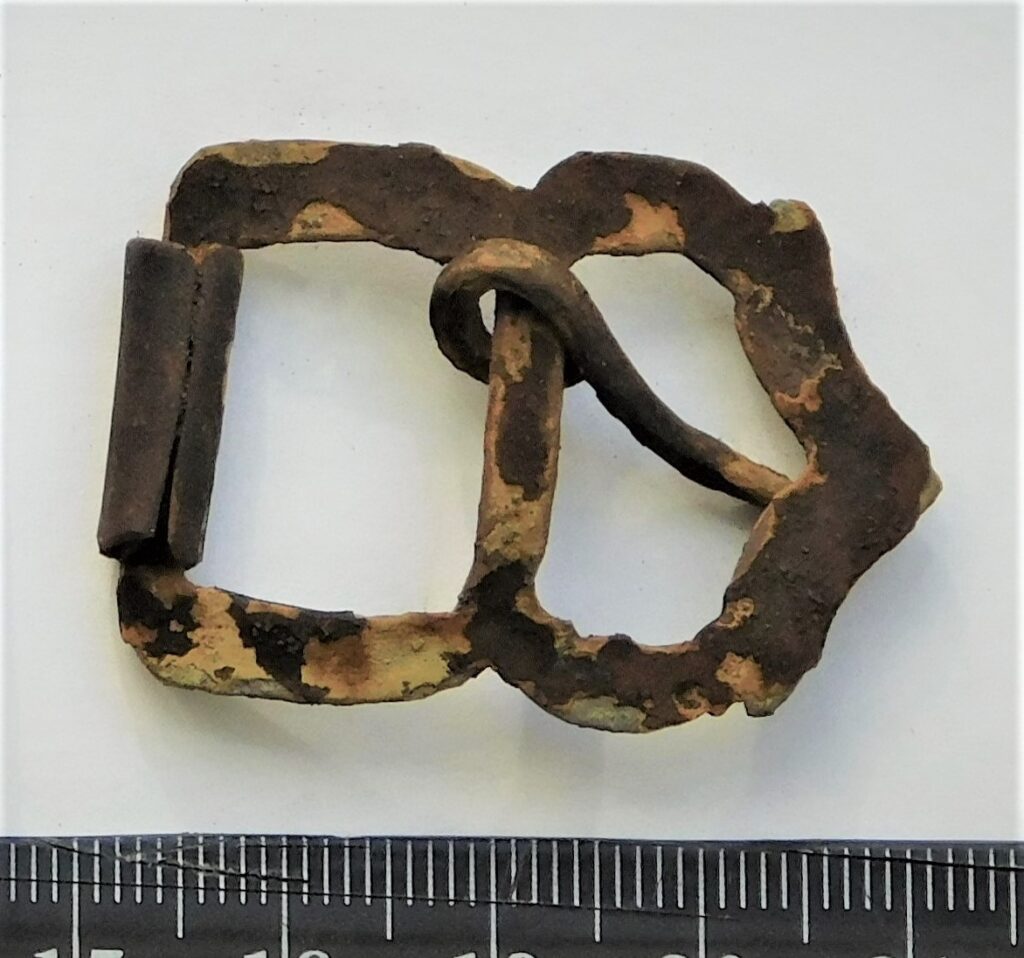Database
Our database is free to use for all history and archaeology enthusiasts. If you use our database, please do not forget to cite correctly:
Mägi, Marika; Palm, Piia Sandra. Archaeological Artefacts of Saaremaa. Foundation Osiliana / Tallinn University. Accessed: date.
The Osiliana Archaeological Database presents artefacts from Saaremaa and the surrounding small islands.
The database contains mainly Iron Age and Medieval finds that can be classified.
Undated metal or other pieces were generally excluded from the database.
Ceramics are represented by isolated examples.
The database is a work in progress and is constantly being updated.


Chisel.
Valjala hillfort
Finger-ring, bronze. This type of finger-ring has a thickened middle section with engraved diagonal grooves. A well-known type of ring in the archaeological material of the Estonian islands often found in both stone graves with cremations as well as inhumation burials.

Finger-ring, bronze. This type of finger-ring has a thickened middle section with engraved diagonal grooves. A well-known type of ring in the archaeological material of the Estonian islands often found in both stone graves with cremations as well as inhumation burials. Could have come into use already during the 12th century AD (Mägi 2002, 109).
Literature:
Mägi, M.; Malve, M. & Toome, T. 2019. Early Christian burials at Valjala churchyard, Saaremaa.– Archaeological Fieldwork in Estonia, 2018, 93−118, 109. Read the article: here.
Mägi, M. 2002. At the Crossroads of Space and Time. Graves, Changing Society and Ideology on Saaremaa (Ösel), 9th–13th centuries AD. CCC papers: 6. Gotland University College, Centre for Baltic Studies; Institute of History, Department of Archaeology. Tallinn, 2002. Read the book: here. Look at the drawings of the archaeological excavations: here.


Spindle whorl.
Literature:
Luik, H. 2004. Luuesemed hilisrauaaja linnamägedel Lõhavere, Soontagana, Varbola ja Valjala leidude põhjal. – A. Haak, E. Russow, A. Tvauri (Toim.). Linnusest ja linnast: uurimusi Vilma Trummali auks = About hillfort and town: studies in honour of Vilma Trummal (157−188). Tallinn, Tartu: Eesti Teaduste Akadeemia Kirjastus. (Muinasaja teadus; 14). Read the article (ENG conclusion p. 185-188): here.
Valjala hillfort
Javelin head with short rhomboid blade and a long tang that thickens in the lowest part, iron.



Javelin head with short rhomboid blade and a long tang that thickens in the lowest part, iron. According to the context it can be dated mainly to the 12th-13th centuries, but as suggested by Brūzis, such rhomboid blades were also characteristic of 14th century javelins (Brūzis 2016, 120-121, Pl. I XIV).
Literature:
Brūzis R. 2016. Tuvcīņas ieroči Latvijā 14.–16. gadsimtā. – Rīga: Latvijas vēstures institūta apgāds.


Bead.
Valjala hillfort
Penannular brooch with faceted terminals, copper alloy.


Penannular brooch with faceted terminals, copper alloy, decorated. Widespread type in Estonia, mainly in the 12th century.
Literature:
Pauts, H. 1997. Pahaga hoburaudsõled Eestis. (Töid ajaloo alalt, I.) Eesti Ajaloomuuseum, Tallinn, 79-115.

Tooth pendant.
Literature:
Luik, H. 2004. Luuesemed hilisrauaaja linnamägedel Lõhavere, Soontagana, Varbola ja Valjala leidude põhjal. – A. Haak, E. Russow, A. Tvauri (Toim.). Linnusest ja linnast: uurimusi Vilma Trummali auks = About hillfort and town: studies in honour of Vilma Trummal (157−188). Tallinn, Tartu: Eesti Teaduste Akadeemia Kirjastus. (Muinasaja teadus; 14). Read the article (ENG conclusion p. 185-188): here.

Crossbow bolt, iron. Crossbow bolt with a pyramid-shaped tip. The bolt has a wider part at the base, just before the socket. Mäesalu´s type A I Crossbow were taken into use in the Eastern Baltic as early as in the end of the 12th century, but heads of such type are in Estonia dated mainly to the first half of the 13th century (Mäesalu 1991). In Latvia they are datef from the end of the 12th century to the early 14th century (Mugurēvičs 2008, 202).
Literature:
Mäesalu, A. 1991. Otepää linnuse ammunooleotsad. Eds. L. Jaanits & V. Lang. (Muinasaja teadus, 1). Agu, Tallinn.
Mugurēvičs, Ē. 2008. Viduslaiku ciems un pils Salaspils novadā. Rīga, 112, 202.



Buckle, bronze. Probably from the 13th century or later.
The negative value refers to time Before Christ.







